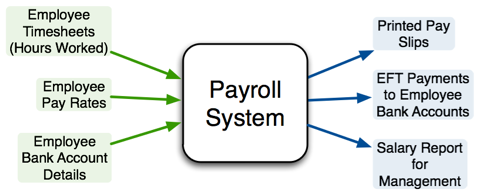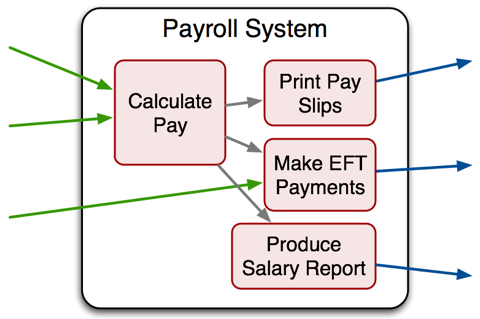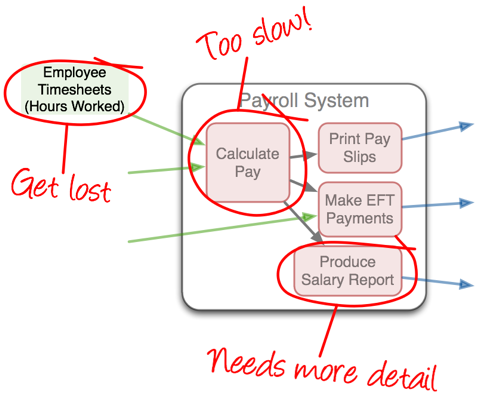Having collected as much information about the present system as possible, the systems analyst now looks though it all to understand how the system works, and to try and identify problems that need to be fixed.
This process is called analysis.
This process is called analysis.
Research
Analysis
Design
Identifying the Inputs, Outputs and Processes
Every system has inputs and outputs and the systems analyst needs to identify the data input to the present system, and the data output.
This is because any new system that is designed will have to deal with similar inputs and outputs as the present system.
For example, the payroll system in a business might have the following inputs and outputs...
This is because any new system that is designed will have to deal with similar inputs and outputs as the present system.
For example, the payroll system in a business might have the following inputs and outputs...

Identifying the inputs, outputs and processes helps the Systems Analyst really understand how a system works:
- What goes in?
- What happens inside?
- What comes out?
Any new system that is created will need to take in the same input data (the number of hours worked by employees), and will have to produce the same three outputs.
For similar reasons, the systems analyst also has to understand how the present system works (the processes – who does what and when)...
For similar reasons, the systems analyst also has to understand how the present system works (the processes – who does what and when)...

It is important to know exactly how the system works because some parts of the present system may work very well, and it would be a waste of time and effort to replace them.
Most large systems are actually made up of many sub-systems. We call these sub-systems processes.
Each process takes data from the inputs or from other processes, processes the data, and produces an output. The output is passed to other processes, and so on.
Each process takes data from the inputs or from other processes, processes the data, and produces an output. The output is passed to other processes, and so on.
Identifying Problems
No system is perfect and it is the job of the systems analyst to try and identify where the problems in a system are.
If these problems can be fixed, the system will work more smoothly, be more efficient and, in the case of a business, be more profitable.
In the above payroll example, the following problems might be identified...
If these problems can be fixed, the system will work more smoothly, be more efficient and, in the case of a business, be more profitable.
In the above payroll example, the following problems might be identified...
- The payroll often takes over three days to process, resulting in many employees being paid late
- Timesheets sometimes get lost before being processed. This means that sometimes pay has to be estimated
- The reports sent to management do not show enough information.

Hopefully you have realised why all of the research and analysis is necessary. Unless we really understand how a system works, we can't begin to identify the parts that are broken and need fixing / replacing
New System Requirements Specification
Now the problems with present system are understood, the system analyst can begin to plan how the new system will fix those problems.
The systems analyst specifies a list of requirements for the new system (‘requirements’ simply means targets or aims).
This list is usually called the Requirements Specification.
For the payroll example the requirements might be...
The systems analyst specifies a list of requirements for the new system (‘requirements’ simply means targets or aims).
This list is usually called the Requirements Specification.
For the payroll example the requirements might be...
- Payroll processing should be completed within 24 hours
- The recording of hours worked should use a system that means the data cannot be lost
- Management reports should contain detailed information about pay for each department, overtime payments and average hours worked by each employee
- Management reports should be electronic so that managers can analyse the data more easily

The whole point of any system analysis is to end up with a better system than presently exists. The Requirements Specification is the document that lists all of the improvements that we hope the new system will bring.
What Hardware and Software Will Be Required?
The systems analysts will now need to decide what hardware and software will be required for the new system...
Hardware
- How many computers?
- What type of network?
- How many servers?
- Any special input devices? (e.g. barcode readers)
- Any special output devices?
Software
- Is ready-made, off-the-shelf software available?
- Is custom-written software required?
Off-the-shelf software is software that is created for use by a large range of customers - it tends to be quite general-purpose.
Custom-written software is designed and written specifically for one customer.
Off-the-shelf software:
Custom-written software is designed and written specifically for one customer.
Off-the-shelf software:
- Cheaper
- More reliable (because most problems will have been found by one of the many users)
- Has lots of support and help available (because lots of other people are using it)
- Very expensive
- Provides exactly what the customer needs (a ‘perfect fit’)
- Only has one user, so little help is available
